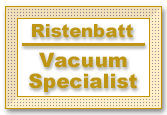An upright type of vacuum cleaner is a self-contained unit which has the motor, main cleaning nozzle, filtering system, etc. all built together in an overall vertical shape. All upright types today have motor driven revolving brush rolls and are used primarily for cleaning carpeted floors. They are pushed forward and pulled backward in front of the user by gripping the narrow handle extending upward from the main case.
The general upright type can be subdivided into three basic types having three unique design characteristics. They are the Traditional Upright, the "Clean-Air" Upright and the Two-Motor Upright. The latter is a fairly new arrival in the vacuum cleaner industry.
Main Characteristics of the Two-Motor Upright
The two-motor upright combines a canister type motor and filtration system in the main body with a power nozzle type nozzle for cleaning carpeted floors. Some, like the Lindhaus HEALTHCAREpro HEPA, and SEBO Felix series are designed to allow the user to remove the main carpet cleaning nozzle and insert a floor brush to better clean bare floors. The basic vertical configuration of the upright is maintained while its versatility is increased. Many uprights having this design conveniently carry the attachments on-board with the hose always attached and ready to use. Most, if not all, two-motor uprights give the user the option of stopping the brush roll for cleaning bare floors or when cleaning with the attachments. Since the brush roll is driven by its own motor, if its rotation slows in thicker carpet, the suction produced by the suction motor is not affected like it would be in a one-motor upright.
Similarities with "Clean-Air" Uprights
Two-motor uprights are also "clean-air" uprights since the air which passes through the suction producing fan or fans is already "clean", having passed through most of the filtering system before reaching it. While two-motor uprights fit this description, the "clean-air" designation typically is used to refer to an upright using only one motor to create the suction and drive the brush roll. As such, it is often used when comparing "clean-air" uprights to "dirty-air" (traditional) uprights.
The air enters the nozzle near the floor and travels toward the paper or cloth filter bag, carrying the dirt with it. The bag retains most of the dirt and dust while allowing the air to pass through its filter media. The air then travels through a filter pad to be cleaned further before entering the high speed suction fan or fans. Since the air is quite clean, it is allowed to flow through the motor to cool it. After leaving the motor the air is often filtered by additional exhaust filters to remove even more fine particles and carbon from the motor brushes before it leaves the vacuum cleaner.
Effects on Cleaning Performance
Depending on the brand, you may find very little difference between the performance of a "two-motor" upright and the one-motor "clean-air" upright. Some "two-motor" uprights, like the Miele, Lindhaus, SEBO, Electrolux (formerly The Eureka Company) and Aerus use cogged or geared type belts to transfer power from the brush motors to the brush rolls. This superior design eliminates belt slippage for better carpet agitation and greatly extends the belt life. Another feature that enhances the carpet cleaning ability is the way that the air inlet in the nozzle is either centered or very close to the center of the nozzle. This provides more consistent air flow and cleaning across the full width of the nozzle.
Performance with Attachments
The canister motor design creates significantly more actual suction (pressure difference) than the traditional upright motor design. This is important for effective cleaning with a hose and attachments due to the higher resistance to air flow present in the hose. The velocity of the air flow plus the amount of the carpet agitation determines how well a vacuum cleaner will pick up the dirt so the shorter the distance the air travels and the larger the air passages, the better the performance will be. Some uprights pull all the air through a long hose even when cleaning with the main carpet nozzle, reducing their performance. For more about suction motor and fan designs, see our articles on Suction Motor Design & Operation and Fan or Impeller Types & Performance.
Identifying Two-Motor Uprights
In summary, "two-motor" as well as other "clean-air" uprights typically produce better performance when using on-board attachments. They also have significantly longer fan and motor lives compared to most "dirty-air" uprights with on-board attachments. Operating noise levels are typically much lower than from their "dirty-air" counterparts. Having a separate motor drive the brush roll, some using a cogged or geared type of belt, can enhance the carpet cleaning ability of "clean-air" uprights. The two-motor design is hard to identify on some models since they look so similar to the one-motor "clean-air" uprights. Other models have a more narrow connector between the main body and carpet cleaning nozzle, making them easier to identify. Most will be identified as having two motors somewhere on the vacuum cleaner or its literature.
Next Vacuum Cleaner Type: Two-Motor Power Team












